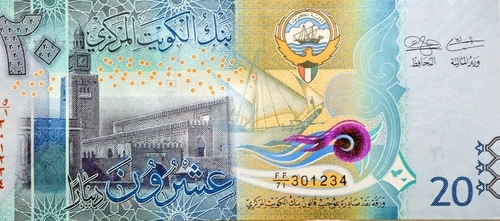The Kuwaiti Dinar (KWD) is more than just currency—it’s a symbol of economic stability and wealth. The KWD has a storied past, impactful present, and a pivotal role in the global economic landscape. This article will explore its origins, current status, factors influencing its value, recent impacts on its performance, and potential future trends.
Historical Context of the Kuwaiti Dinar
Introduced in 1961 following Kuwait’s independence from the United Kingdom, the Kuwaiti Dinar replaced the Gulf Rupee, which had been tied to the Indian Rupee. Upon its introduction, the dinar was pegged to the British Pound Sterling. This move marked the beginning of Kuwait’s independent monetary policy.
During the Iraqi invasion in 1990, the Iraqi Dinar temporarily replaced the KWD. However, after Kuwait’s liberation in 1991, the Kuwaiti government issued a new series of banknotes and restored the KWD as the official currency. The quick recovery and re-establishment of the dinar solidified its importance in the post-liberation period.
Current Status of the Kuwaiti Dinar
As of 2025, the Kuwaiti Dinar remains a valuable currency, with 1 KWD equivalent to approximately $3.20 or 277.77 Indian Rupees. Its robust value reflects the strength of Kuwait’s economy, which is underpinned by substantial oil and gas reserves. The currency is managed by the Central Bank of Kuwait, which employs prudent monetary policies to maintain the dinar’s stability.
Kuwait’s economic standing enjoys global recognition for its unmatched per capita income and fiscal health. The nation’s sovereign wealth fund, managed through the Kuwait Investment Authority, further enhances its financial resilience by diversifying income streams beyond oil revenues.
Factors Influencing the Value of the Kuwaiti Dinar
Several key factors contribute to the KWD’s high valuation:
-
Oil Wealth
Kuwait holds approximately 6% of the world’s proven oil reserves. Oil exports are the backbone of the Kuwaiti economy, providing a continual flow of wealth that supports the currency’s value. -
Managed Currency Regime
Unlike freely floating currencies, the Kuwaiti Dinar is pegged to an undisclosed basket of currencies rather than a single one like the U.S. Dollar. This reduces volatility and aligns the dinar with the trading patterns of its key economic partners. -
Strong Economic Fundamentals
Low levels of public debt and consistent budget surpluses contribute to economic stability. The Kuwaiti government invests heavily in infrastructure and healthcare, fostering overall economic growth, which in turn bolsters the strength of the dinar. -
Small Population
With a modest population of around 4.6 million, the wealth generated by its oil reserves is spread across fewer people, making its per capita income among the highest globally.
Recent Developments and Impacts on the Dinar
Recent years have seen significant economic developments affecting the Kuwaiti Dinar:
-
Oil Price Volatility
Kuwait’s reliance on hydrocarbons makes it susceptible to fluctuations in global oil prices. However, the Kuwaiti government has worked to mitigate these effects through a robust sovereign wealth fund, which is one of the largest globally. -
Economic Diversification Efforts
The government’s Vision 2035 reform plan includes initiatives aimed at reducing oil dependency. Investments in finance, tourism, and infrastructure have begun to contribute to economic stability, securing a broader foundation for the KWD’s strength over the long term. -
Pegging Policy Stability
The Central Bank of Kuwait’s adherence to a currency basket peg ensures the dinar remains relatively insulated from global currency uncertainties, further enhancing investor confidence.
Role of the Kuwaiti Dinar in the Global Economy
The Kuwaiti Dinar plays a crucial role in international finance, particularly within the Middle East. Its stability enables Kuwait to facilitate regional investments and trade. Additionally, the dinar’s reliability attracts expatriates from across the globe, many of whom remit money to their home countries, amplifying its reach beyond domestic borders.
Furthermore, the dinar’s strong value makes it a benchmark in the global oil trade. Kuwait’s exports are often priced in hard currencies like the U.S. Dollar, but the strong domestic currency ensures a competitive edge in maintaining purchasing power for imports.
Future Outlook for the Kuwaiti Dinar
Looking ahead, the following trends are likely to shape the trajectory of the Kuwaiti Dinar:
-
Economic Diversification
Kuwait’s push to reduce oil dependency, particularly via investments in renewable energy and technology, could provide new channels for economic growth, underpinning the currency’s strength. -
Global Energy Transition
The global shift towards renewable energy sources may challenge Kuwait’s traditional oil-driven economy. However, prudent fiscal management and strategic investments are expected to mitigate the impact on the dinar’s value. -
Geopolitical Stability
Kuwait enjoys a relatively stable geopolitical position in the Gulf. Continued diplomatic balance will likely reinforce economic confidence, benefiting the dinar.
